
Solanum is a large and diverse genus of flowering plants, which include three food crops of high economic importance: the potato, the tomato and the eggplant. It also contains the nightshades and horse nettles, as well as numerous plants cultivated for their ornamental flowers and fruit.
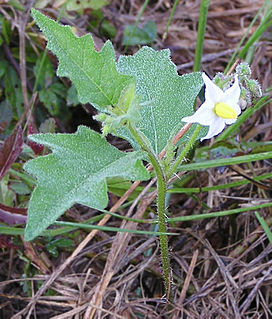
Solanum carolinense, the Carolina horsenettle, is not a true nettle, but a member of the Solanaceae, or nightshade family. It is a perennial herbaceous plant, native to the southeastern United States that has spread widely throughout much of temperate North America. It has also been found in parts of Europe, Asia, and Australia. The stem and undersides of larger leaf veins are covered with prickles.

Solanum quitoense, known as naranjilla in Ecuador, Costa Rica, and Panama and as lulo in Colombia, is a tropical perennial plant from northwestern South America. The specific name for this species of nightshade means "from Quito."

Solanum americanum, commonly known as American black nightshade, small-flowered nightshade or glossy nightshade is a herbaceous flowering plant of wide though uncertain native range. The certain native range encompasses the tropics and subtropics of the Americas, Melanesia, New Guinea, and Australia.

Solanum mammosum is commonly known as nipplefruit, fox head, cow's udder, or apple of Sodom, is an inedible Pan-American tropical fruit. The plant is grown for ornamental purposes, in part because of the distal end of the fruit's resemblance to a human breast, while the proximal end looks like a cow's udder. It is an annual in the family Solanaceae, and part of the genus Solanum, making the plant a relative of the eggplant, tomato, and potato. This poisonous fruit is native to South America, but has been naturalized in Southern Mexico, Greater Antilles, Central America, and the Caribbean. The plant adapts well to most soils, but thrives in moist, loamy soil.

Solanum ptychanthum, the West Indian nightshade or eastern black nightshade, is an annual or occasionally perennial plant in the Solanaceae (Nightshade) family. It is typically 15–60 cm tall and many branched.

Lycopersicon was a genus in the flowering plant family Solanaceae. It contained about 13 species in the tomato group of nightshades. First removed from the genus Solanum by Philip Miller in 1754, its removal leaves the latter genus paraphyletic, so modern botanists generally accept the names in Solanum. The name Lycopersicon is still used by gardeners, farmers, and seed companies. Collectively, the species in this group apart from the common cultivated plant are called wild tomatoes.

Solanum sessiliflorum, the cocona, is a tropical shrub of the family Solanaceae. The cocona plant has sturdy branches and huge, serrate and hairy leaves. Cocona closely resembles a number of close relatives, including naranjilla and pseudolulo. It can be distinguished from those plants by its lack of spines. It will hybridize with those and other close relatives. Cocona also lacks the characteristic purple coloring usually seen in the naranjilla. Its flowers resemble large potato flowers, with light green petals. Cocona is harvested in parts of South America around the Amazon rainforest such as Purús Province in eastern Peru.

Solanum elaeagnifolium, the silverleaf nightshade or silver-leaved nightshade, is a common native plant to parts of the southwestern USA, and sometimes weed of western North America and also found in South America. Other common names include prairie berry, silverleaf nettle, white horsenettle or silver nightshade. In South Africa it is known as silver-leaf bitter-apple or satansbos. More ambiguous names include "bull-nettle", "horsenettle" and the Spanish "trompillo". The plant is also endemic to the Middle East.
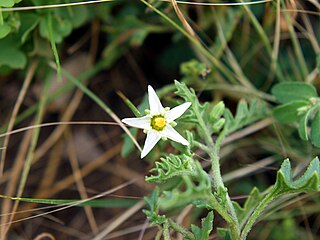
Solanum sarrachoides is a species of South American nightshade known as the hairy nightshade or leafy-fruited nightshade.
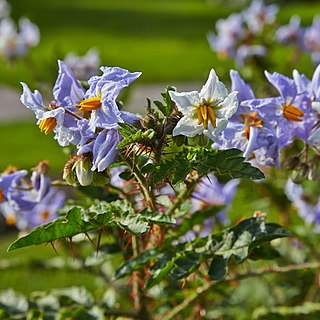
Solanum sisymbriifolium is commonly known as vila-vila, sticky nightshade, red buffalo-bur, the fire-and-ice plant, litchi tomato, or Morelle de Balbis.

Solanum bahamense, commonly known as the Bahama nightshade, is a plant in the nightshade family. It is native across the West Indies, from the Florida Keys east to Dominica. It is a common species in coastal habitats, often on calcareous soils.

Solanum lanceolatum, with the common names orangeberry nightshade and lanceleaf nightshade, is a species of nightshade. It is native to regions of South America, including the Cerrado ecoregion of the Tropical and subtropical grasslands, savannas, and shrublands biome, primarily in Brazil.

Solanum physalifolium, known as hoe nightshade, Argentine nightshade, green nightshade and hairy nightshade, is a species in the family Solanaceae. Native to Argentina, Bolivia and Chile, it is widely naturalized in Australia, New Zealand, Europe, western Canada and the north western United States. Solanum physalifolium has been widely but incorrectly known as Solanum sarrachoides, a different species. It has been listed as a noxious weed in the US states of Kansas and Michigan under this misapplied name.
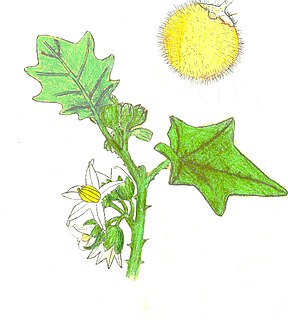
Solanum lasiocarpum, synonym Solanum feroxL., otherwise known as Indian nightshade or hairy-fruited eggplant, is a plant that produces edible fruit. Its flowers are white and its fruits are pale yellow.

Solanum seaforthianum, the Brazilian nightshade, is a flowering evergreen vine of the family Solanaceae native to tropical South America. As a member of the Solanum genus, it is related to such plants as the tomato and potato. It is characterized by clusters of four to seven leaves and can climb to a height of 6 m (20 ft) given enough room. It blooms in the mid to late summer with clusters of star-shaped purple inflorescence followed by scarlet marble-sized berries. The plant is highly heat resistant, but cannot tolerate frost conditions. The plant contains modest amounts of various tropane alkaloids such as atropine, scopolamine and hyoscyamine and should be considered mildly toxic and inedible. Promising molluscicidal and schistosomicidal activities were displayed for the S. seaforthianum extracts and fractions which are attributed to the glycoalkaloid content.
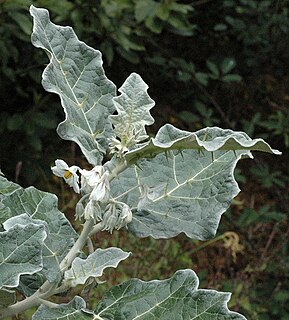
Solanum marginatum is a species of plant in the family Solanaceae known by the common names purple African nightshade and white-margined nightshade. It is native to Ethiopia and Eritrea, and it is known on other continents as an introduced species and sometimes a weed. It is a hairy shrub growing up to two meters tall. The large, distinctive, gray-green leaves are wavy along the edges, woolly on the undersides, and measure up to 18 centimeters long. The veins are white and lined with large, widely spaced prickles. The inflorescence contains several white flowers, hanging or nodding bisexual flowers and erect staminate flowers with large yellow anthers. The fruit is a yellow berry up to 5 centimeters wide.

Solanum glaucophyllum is a species of plant in the family Solanaceae. It is known as waxyleaf nightshade. It is native to Brazil, Bolivia, Argentina, Paraguay and Uruguay.

Solanum diphyllum, commonly known as the twoleaf nightshade, is a species of nightshade native to the Americas. It is cultivated as an ornamental plant for its clusters of dark green round fruits that turn a bright yellow when ripe.
Solanum clokeyi, known as Clokey's nightshade, Island nightshade, or Santa Cruz Island nightshade, is a species of flowering plant in the nightshade family endemic to California, United States. It occurs in southeastern California, including the Channel Islands and Santa Catalina Island. The name honors American botanist Ira Waddell Clokey. It is sometimes treated as a synonym or variety of Solanum wallacei.



















